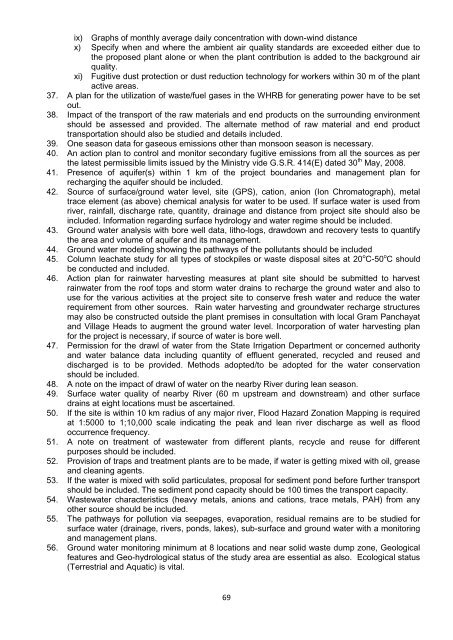1 Minutes of the 36th Meeting of the Expert Appraisal Committee ...
1 Minutes of the 36th Meeting of the Expert Appraisal Committee ...
1 Minutes of the 36th Meeting of the Expert Appraisal Committee ...
Create successful ePaper yourself
Turn your PDF publications into a flip-book with our unique Google optimized e-Paper software.
ix) Graphs <strong>of</strong> monthly average daily concentration with down-wind distancex) Specify when and where <strong>the</strong> ambient air quality standards are exceeded ei<strong>the</strong>r due to<strong>the</strong> proposed plant alone or when <strong>the</strong> plant contribution is added to <strong>the</strong> background airquality.xi) Fugitive dust protection or dust reduction technology for workers within 30 m <strong>of</strong> <strong>the</strong> plantactive areas.37. A plan for <strong>the</strong> utilization <strong>of</strong> waste/fuel gases in <strong>the</strong> WHRB for generating power have to be setout.38. Impact <strong>of</strong> <strong>the</strong> transport <strong>of</strong> <strong>the</strong> raw materials and end products on <strong>the</strong> surrounding environmentshould be assessed and provided. The alternate method <strong>of</strong> raw material and end producttransportation should also be studied and details included.39. One season data for gaseous emissions o<strong>the</strong>r than monsoon season is necessary.40. An action plan to control and monitor secondary fugitive emissions from all <strong>the</strong> sources as per<strong>the</strong> latest permissible limits issued by <strong>the</strong> Ministry vide G.S.R. 414(E) dated 30 th May, 2008.41. Presence <strong>of</strong> aquifer(s) within 1 km <strong>of</strong> <strong>the</strong> project boundaries and management plan forrecharging <strong>the</strong> aquifer should be included.42. Source <strong>of</strong> surface/ground water level, site (GPS), cation, anion (Ion Chromatograph), metaltrace element (as above) chemical analysis for water to be used. If surface water is used fromriver, rainfall, discharge rate, quantity, drainage and distance from project site should also beincluded. Information regarding surface hydrology and water regime should be included.43. Ground water analysis with bore well data, litho-logs, drawdown and recovery tests to quantify<strong>the</strong> area and volume <strong>of</strong> aquifer and its management.44. Ground water modeling showing <strong>the</strong> pathways <strong>of</strong> <strong>the</strong> pollutants should be included45. Column leachate study for all types <strong>of</strong> stockpiles or waste disposal sites at 20 o C-50 o C shouldbe conducted and included.46. Action plan for rainwater harvesting measures at plant site should be submitted to harvestrainwater from <strong>the</strong> ro<strong>of</strong> tops and storm water drains to recharge <strong>the</strong> ground water and also touse for <strong>the</strong> various activities at <strong>the</strong> project site to conserve fresh water and reduce <strong>the</strong> waterrequirement from o<strong>the</strong>r sources. Rain water harvesting and groundwater recharge structuresmay also be constructed outside <strong>the</strong> plant premises in consultation with local Gram Panchayatand Village Heads to augment <strong>the</strong> ground water level. Incorporation <strong>of</strong> water harvesting planfor <strong>the</strong> project is necessary, if source <strong>of</strong> water is bore well.47. Permission for <strong>the</strong> drawl <strong>of</strong> water from <strong>the</strong> State Irrigation Department or concerned authorityand water balance data including quantity <strong>of</strong> effluent generated, recycled and reused anddischarged is to be provided. Methods adopted/to be adopted for <strong>the</strong> water conservationshould be included.48. A note on <strong>the</strong> impact <strong>of</strong> drawl <strong>of</strong> water on <strong>the</strong> nearby River during lean season.49. Surface water quality <strong>of</strong> nearby River (60 m upstream and downstream) and o<strong>the</strong>r surfacedrains at eight locations must be ascertained.50. If <strong>the</strong> site is within 10 km radius <strong>of</strong> any major river, Flood Hazard Zonation Mapping is requiredat 1:5000 to 1;10,000 scale indicating <strong>the</strong> peak and lean river discharge as well as floodoccurrence frequency.51. A note on treatment <strong>of</strong> wastewater from different plants, recycle and reuse for differentpurposes should be included.52. Provision <strong>of</strong> traps and treatment plants are to be made, if water is getting mixed with oil, greaseand cleaning agents.53. If <strong>the</strong> water is mixed with solid particulates, proposal for sediment pond before fur<strong>the</strong>r transportshould be included. The sediment pond capacity should be 100 times <strong>the</strong> transport capacity.54. Wastewater characteristics (heavy metals, anions and cations, trace metals, PAH) from anyo<strong>the</strong>r source should be included.55. The pathways for pollution via seepages, evaporation, residual remains are to be studied forsurface water (drainage, rivers, ponds, lakes), sub-surface and ground water with a monitoringand management plans.56. Ground water monitoring minimum at 8 locations and near solid waste dump zone, Geologicalfeatures and Geo-hydrological status <strong>of</strong> <strong>the</strong> study area are essential as also. Ecological status(Terrestrial and Aquatic) is vital.69
















